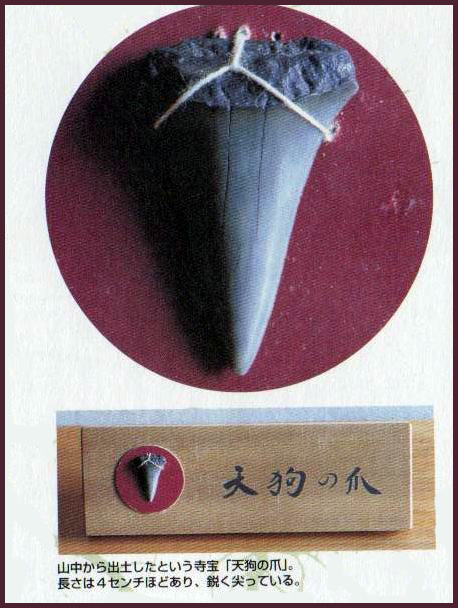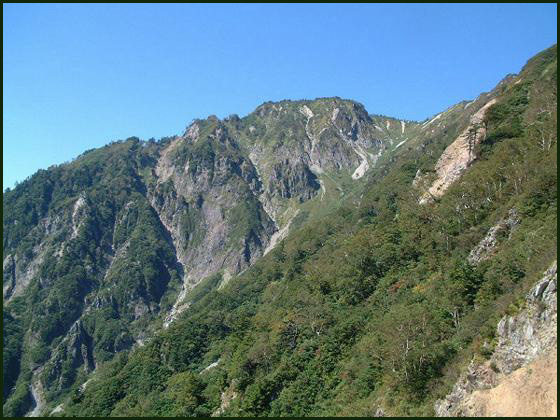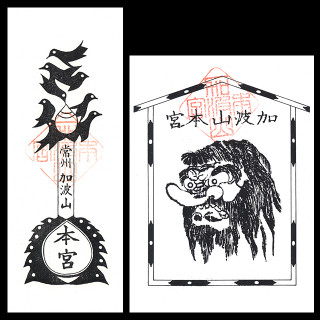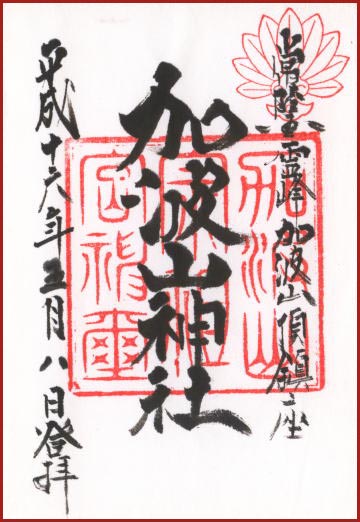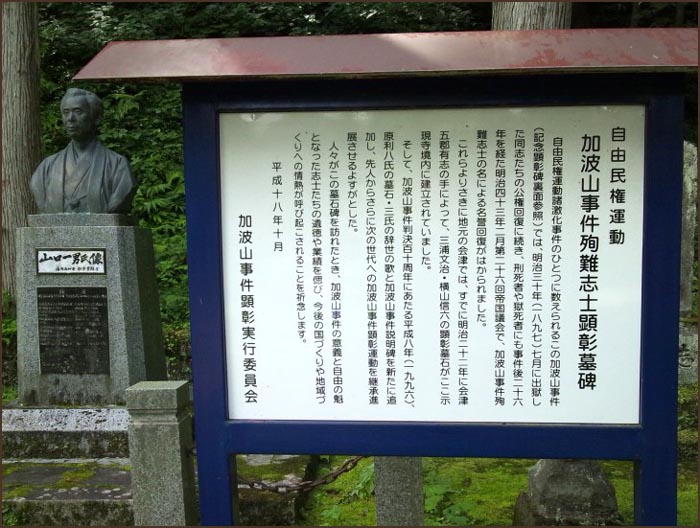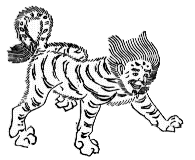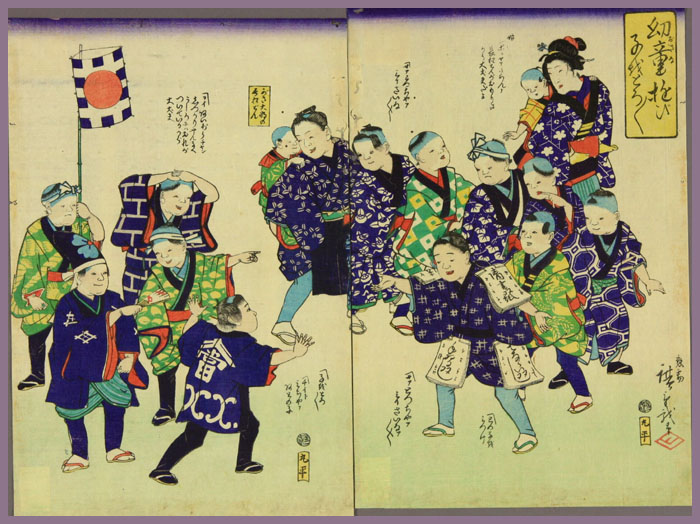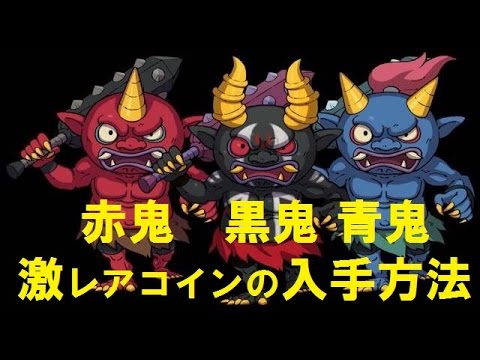[ . BACK to DARUMA MUSEUM TOP . ]
. Onipedia - 鬼ペディア - Oni Demons - ABC-List - .
. mamono 魔物 monster, ogre, devil, evil spirit, demon .
:::::::::::::::::::::::::::::::::::::::::::::::::::::::::::::::::::::::::::::::::::::::::::::::::::::::::::::::::::::::::::::::::::::::::::::::::::::::::::::::::::::::::::::::::::
madoo 魔道 - まどう Mado, road where monsters pass
ma no toorimichi 魔の通り道 / masuji, ma-suji 魔筋
mamono no toorimichi 魔物の通り道
nawasuji, nawa-suji 縄筋
The term
mamono can be translated in various ways. I will use "monster", to make a difference from the Oni.
. mamono 魔物 monster, ogre, devil, evil spirit, demon .
- Introduction -
 nawasuji 縄筋(なわすじ) "road like a rope"
nawasuji 縄筋(なわすじ) "road like a rope"
"Monster roads" are known in many parts of Japan.
They are said to be 細長い一本道 very long, narrow, straight roads and people should not built homes near them.
Mado can also indicate a monster that passes on this road.
:::::::::::::::::::::::::::::::::::::::::::::::::::::::::::::::::::::::::::::::::::::::::::::::::::::::::::::::::::::::::::::::::::::::::::::::::::::::::::::::::::::::::::::::::::
. Japanese Legends - 伝説 民話 昔話 – ABC-List .
..............................................................................................................................................
愛媛県 Ehime
今治市
Imabara town 玉川町 Tamagawa
The road from the lower house to the upper house of 大野の観音様 Ono no Kannon-sama is called
魔の通り道 Monster Road.
Most people avoid to walk along.
..............................................................................................................................................
兵庫県 Hyogo
.......................................................................
佐用郡
Sayo district
If someone falls on a 縄筋 Monster Road, he will become ill, therefore people try to avoid these roads.
..............................................................................................................................................
香川県 Kagawa
In the village 川津村 Kawatsumura in 1939, they were trying to built a new road across an old Nawasuji Monster Road. But all the workers who helped at the construction site got ill, with strong chest pain and could not continue. Some said they saw a strange monster with a black face and red mouth in their delirium.
Some heard a noise like throwing pebbles at the window pane.
Many had a new kamidana 神棚 Shelf for the Gods placed in their home and after purification rituals, the strange phenomenon stopped.
..............................................................................................................................................
長野県 Nagano
.......................................................................
下伊那郡
Shimoina district 遠山村
Toyama
If someone falls asleep in the mountains with his head facing South (minami makura 南枕 pillow in the South), Mado comes as a monster and disturbs him or makes him ill; this is also called
kami makura 神枕 "pillow of the Gods".
Sleeping with the head facing North (kita makura 北枕) will prevent the Mado monster from doing harm.
..............................................................................................................................................
岡山県 Okayama
The Monster Roads of Okayama are well researched, thanks to the anthropologist
- - - - - Miura Shūyū 三浦秀宥 Miura Shuyu
ナメラ筋系伝承魔道考 namera suji
.......................................................................
namerasuji,
namera-suji ナメラスジ is the local dialect for
nawasuji 縄筋.
Other names are
ナマムメスジ namamonosuji, namamono suji and 魔物筋(まものすじ)mamonosuji, mamono suji
kemonosuji, kemono suji ケモノスジ "path of wild animals" is sometimes used.
If people try to build a house along such a Monster Road, they will soon get ill or hurt or there will be fire.
Families living along such a road will never be prosperous and have to observe a lot of taboos.
In former times people often met a Mado monster during the ninth lunar month. In that case they would get a strong headache and had to stay ill in bed for a long time when they came home.
.......................................................................
The pass 遍照寺峠
Henshoji Toge is called a Monster Road.
It is also the road of a 狗嬪
Gubin Yokai monster.
The pass 平の峠 is called a Monster Road.
In the 久米郡 Kume district, 旭町 Asahi, 倭文村 Shitorison village there is a mountain hamlet with a monster road.
In the 苫田郡 Tomata district, 芳野村 Yoshinomura there is a monster road.
........................................................................................................
英田郡
Aida district
In the village 栗広村 Awahiro son people could hear the scary noise of someone stomping on fallen leaves on the road. They called the road
kemonosuji ケモノスジ
.......................................................................
赤磐郡
Akaiwa district
kemonosuji, kemono suji ケモノスジ path of wild animals
near the village 竹枝町 Takeeda son. At night the monsters pass here.
.............................................................................................................................................
上房郡
Jobo district
The Monster Road of 上房郡呰部町 Azae village has now been turned into a park of Shrine 厳島神社 Itsukushima Jinja.
In a corner of the park is a public toilet. Once a man had to use during the daytime, but inside he saw a huge hand reaching out toward him and fled in panic.
.......................................................................
勝山町
Katsuyama town 魔筋
In the hamlet 延風部落 Nobukaze there is a Monster Road. If people walk along it an night, their hair begins to stand on end. If a crow calls out while walking there, someone is bound to die soon.
Once an old woman had died. On the way to bring her casket to the the cemetery it was already late and they had to pass the Monster Road. They hurried along, feeling the casket getting lighter and lighter. When they checke the next morning, there was no body in the casket any mor.
.......................................................................
久米郡
Kume district
久米郡倭文村桑上、貴船神社の、通称奥の院と称される狼様は、火難盗難の守護神である。12月18日の祭に狼の足跡のある石がある狼様の下の池で米をといで神職が捧げると、狼が出てきてそれを食べるという行事が伝えられている。
.
久米郡倭文西村里公文ではナマメスジは山の坂道に当り、其処を通ると髪の毛が立つように思われ、時折は風もないのにゴワゴワと木の葉が揺れる。
.
国米某氏が、昭和7,8年頃久米郡三保村錦織のナマメスジを自動車を運転して通りかかると、路上に2つの光りものが見え、そのまま突っ込むと下の川の方に消えた。あまりの恐ろしさに夢中で帰宅すると、全身冷や汗をかき鳥肌になっていた。
.......................................................................
真庭郡
Maniwa district
In the village 川東村 Kawahigashimura behind the local school there was a マメスジ
Namamesuji. In the evening people could hear the noise of huge animals passing there. They called the monster animals ナマメ
Namame.
.
In the village 美川村
Mikawamura below the shrine 栗原神社 Kurihara Jinja there is a Namerasuji, and sometimes a 白狐 white fox can be seen there.
.
In the village 津田村 Tsudamura there is a Namerasuji toward the village 西川村 Nishikawa in Kume. It is a scary road and people usually do not walk there. It was especially scary in the ninth lunar month.
.......................................................................
真庭郡
Maniwa district 美和村
Miwason
In the village Miwason are quite a few monster roads. The monsters are creatures other than the 12 zodiac animals.
If people try to build a house along their road, they will soon get ill or hurt or there will be fire.
Families living along this road will never be prosperous and have to observe a lot of taboos..
.......................................................................
真庭郡
Maniwa district 落合町
Ochiai
While building new roads, especially between 津山市 Tsuyama town and Ochiai, they had to cross various Monster Roads. But many villages did not allow this and the roads had to be build across another path, avoiding homes and places with suspicious old legends about Monster Roads.
.......................................................................
津山市
Tsuyama town
A Monster Road is often crossing with a path of wild animals. At a certain farm house they had to cut down the mud wall around the estate to make place for the invisible Monster Road crossing.
..............................................................................................................................................
滋賀県 Shiga
大津市
Otsu town
Myoogi Hooshi 妙義法師 Priest Myogi Hoshi
When he stayed at 比叡山 Mount Heiizan, he took it upon himself to teach the lay people about monsters and bad deeds by becoming a Mado himself.
Because of his deeds, the Tengu are venerated at Hieizan.
. Myoogi Hooshi 妙魏法師 Myogi Hoshi .
changing his name from
明魏 Meigi to 妙義 Myogi, and also changing the name of the Mountain range in his honor.
Tengu Myoogizan Nikkooboo 妙義山日光坊 Nikko-Bo, Nikkobo, Myogisan
..............................................................................................................................................
徳島県 Tokushima
The wolves here are just a bit larger than normal dogs and like to be with people, especially the forest workers.
When asked "送っていってつかわれ", they will accompany a forest worker back home and teach him to avoid the Mado roads. If the wolf sits down, the worker has to sit down too and wait.
When they reach the home of a worker, his wive has to prepare some rice with soy beans and place it outside the gate.
Next morning the food will be gone and the wolves are content, helping again the next time.
:::::::::::::::::::::::::::::::::::::::::::::::::::::::::::::::::::::::::::::::::::::::::::::::::::::::::::::::::::::::::::::::::::::::::::::::::::::::::::::::::::::::::::::::::::
 まどうと山犬さま The Monster Road and the Wolves
Once upon a time
まどうと山犬さま The Monster Road and the Wolves
Once upon a time
in 阿哲
Atetsu in Okayama at the pass 十文字峠 Jumonji Toge, there were two hungry wolves. They often went down to the village and killed a horse or some chicken for their food. When they were thirsty, they even licked the pee from the outside toilet. The villagers were afraid of them and dared not go to the toilet at night.
But there was an even worse creature at the pass 十文字峠 Jumonji Toge, a 魔物 monster called まどう
Mado, but nobody had ever seen it. The villagers were so afraid of Mado, they used the pass only at the most urgent times.
There was a fish monger named 吾作 Gosaku, who carried fresh fish to the village every day and had to pass this pass.
On top he called out "Hey, dear wolves, come for lunch!"
and placed two fresh fish on the side of the road.

One day Gosaku was late and had to cross the pass in the evening. The wolves had been waiting for him for a long time already and were just about to jump at him to kill him, as he thought.
"Well, I gave you food every day and this is your response . . . but it can't be helped! Go ahead and eat me!"
Just then a strong wind begun to blow and the mountain groaned. From down the valley the fearful Mado monster showed up. The two wolves jumped on Gosaku and hid his body on the ground, so that the Mado could not see him.
Mado could not find Gosaku and eventually disappeared down the other side of the valley.
Gosaku survived thanks to the greatfull wolves after all !
The villagers finally realized that the wolves were the messengers of the Mountain Deity. Other villagers now also brought food offerings to the pass and in the course of time the wolves never came down any more to raid the village animals.
- - - - - まんが日本昔ばなし - manga Nihon mukashibanashi
- reference : nihon.syoukoukai.com/modules -
:::::::::::::::::::::::::::::::::::::::::::::::::::::::::::::::::::::::::::::::::::::::::::::::::::::::::::::::::::::::::::::::::::::::::::::::::::::::::::::::::::::::::::::::::::
. Tengupedia - 天狗ペディア - Tengu ABC-List .
 Tengu 天狗 "heavenly dog" - "celestial dog"
Tengu no tooorimichi 天狗の通り道 / テングノトオリミチ road where Tengu pass
Tengu 天狗 "heavenly dog" - "celestial dog"
Tengu no tooorimichi 天狗の通り道 / テングノトオリミチ road where Tengu pass
Sometimes walking along a mountain road, there is a sudden gust of wind and roaring. This is called
. Tengu tsubute 天狗つぶて / 天狗礫 "Tengu throwing stones" .
.......................................................................
千葉県
Chiba 館山市
Tateyama
In 滝田 Takita there is a Tengu road, where they pass with the most strange sounds when flying past. It is a rather deep forest and sometimes the forest workers, who stay over night in a small hut, can feel it moving and shaking.
.......................................................................
岡山県
Okayama
In some parts of 真庭郡 Maniwa district there are mountains and deep forests, where humans rarely go. There are large pine trees where Tengu come to rest their wings.
Sometimes the Tengu make trees fall down and the mountains squeek. If a forest worker hears that sound, he has to lie down flat on the ground and wait until its over. This is also called
tengu-daoshi 天狗倒し.
.......................................................................
岡山県
Okayama 北房町
Hokubo
Kishiojin キシオジン the female deity Kishio-Jin
(Her name in the local dialect.)
キシオジンの通り筋 road where Kishiojin passes / Kishiojin-suji キシオジン筋
. Kishimojin, Kishibojin 鬼子母神 Kariteimoten (Hariti) - Legends .
.......................................................................
岡山県
Okayama 真庭郡
Maniwa district
There are various Tengu Paths, but nobody knows exactly where they are.
There are also living quarters of the Tengu, and if a person crosses their way, he will be thrown flat on the ground
tengu-daoshi 天狗倒し
.......................................................................
富山県 Toyama 福光町
Fukumitsumachi
Two stems of a tree are becoming one in mid-air. They are called
kamisama no ki カミサマノキ (tengusama no ki テングサマノキ) - tree of the Gods,
tree of the Tengu
Inbetween is a "Tengu Road".
These trees should never be cut down, but if they have to be, there is a great sound when they fall to the ground.
:::::::::::::::::::::::::::::::::::::::::::::::::::::::::::::::::::::::::::::::::::::::::::::::::::::::::::::::::::::::::::::::::::::::::::::::::::::::::::::::::::::::::::::::::::
. okuri ookami 送り狼 "a wolf following someone" .
often along a Monster Road.
............................................................................................................................................
kitsune no michi 狐の道 "Fox Road" in Okayama
There is a "Fox Road" . long and narrow, and somewhere in the middle is a boulder with a hole, where a fox family lives. The fox uses this road to get out in the evening and come down to the hamlet. In the morning, he goes home to his hole. Villagers try to avoid passing the road by this boulder. They also do not dare to climb on it, because that would be sitting on the back of the fox and then being taken off to the sky. So they see the boulder as a Shinto anctuary and sometimes come to pray here.
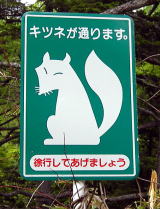
.......................................................................

Kitsune no okurimichi キツネの道送り - A folktale from Kumamoto
- reference source : Manga Nihon Mukashibanashi -
. kitsune densetsu 狐 伝説 fox legends .
:::::::::::::::::::::::::::::::::::::::::::::::::::::::::::::::::::::::::::::::::::::::::::::::::::::::::::::::::::::::::::::::::::::::::::::::::::::::::::::::::::::::::::::::::::
- reference : nichibun yokai database 妖怪データベース -
魔道 - ok // 魔筋 - ok
魔の通り道 - ok
.......................................................................
 source : shotakotake.com/yokai
source : shotakotake.com/yokai
:::::::::::::::::::::::::::::::::::::::::::::::::::::::::::::::::::::::::::::::::::::::::::::::::::::::::::::::::::::::::::::::::::::::::::::::::::::::::::::::::::::::::::::::::::
 . - - - Join the Onipedia friends on facebook ! - - - .
. - - - Join the Onipedia friends on facebook ! - - - .
:::::::::::::::::::::::::::::::::::::::::::::::::::::::::::::::::::::::::::::::::::::::::::::::::::::::::::::::::::::::::::::::::::::::::::::::::::::::::::::::::::::::::::::::::::
. Onipedia - 鬼ペディア - Oni Demons - ABC-List - .
. Tengu 天狗と伝説 Tengu legends "Long-nosed Goblin" .
. - yookai, yōkai 妖怪 Yokai monsters - .
. Legends and Tales from Japan 伝説 - Introduction .
. Mingei 民芸 Regional Folk Art from Japan .
:::::::::::::::::::::::::::::::::::::::::::::::::::::::::::::::::::::::::::::::::::::::::::::::::::::::::::::::::::::::::::::::::::::::::::::::::::::::::::::::::::::::::::::::::::
[ . BACK to DARUMA MUSEUM TOP . ]
[ . BACK to WORLDKIGO . TOP . ]
- #madoo #mado #monsterroad -
:::::::::::::::::::::::::::::::::::::::::::::::::::::::::::::::::::::::::::::::::::::::::::::::::::::::::::::::::::::::::::::::::::::::::::::::::::::::::::::::::::::::::::::::::::
